Tulips are easy to grow garden plants that come in a wide range of colors and varieties. Cultivation of tulips is easy if you are well aware of the factors that support their growth.
One crucial factor that will determine tulips’ growth is their planting location. And in this article we shall discuss all about where is the best place to plant tulips and what factors should you consider while doing so.
Generally, tulips prefer a spot that gets full sun or bright direct sunlight for 8-10 hours a day. However, if you live in USDA zones 7-9, you must ensure your tulips are protected during the hottest part of the day as too much heat can scorch the plant. Also, protect them from strong winds.
This article will help you determine the ideal place for growing tulips.
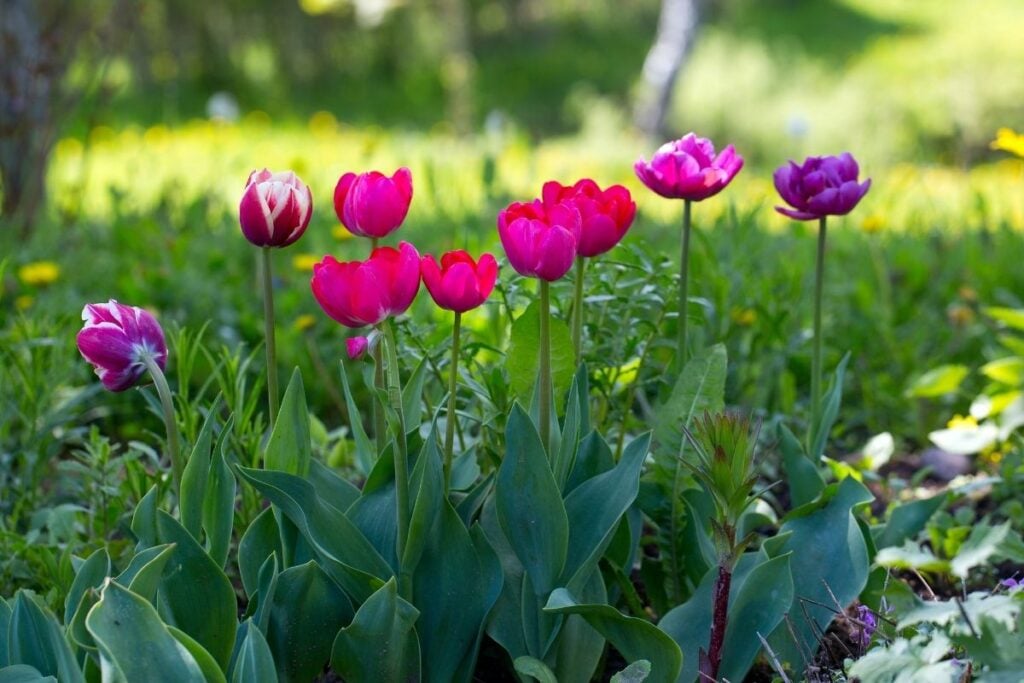
Are tulips annuals or perennials?
Whether tulips are perennial or annuals depends on the place where they are planted. These plants are highly affected by their natural environment.
They will grow as perennials in conditions that match cold winters, dry summers of their native region. In such weather conditions, they will come back year after year.
But garden-grown tulips may not behave like perennials.
Even if tulips return, they won’t have blooms, or maybe they will be smaller in size. This phenomenon happens because of the different environments that might not be suitable for growing as perennials.
The best thing is to plant them annually in autumn and wait for the spring blooms in challenging conditions.
What are the factors that determine the ideal planting location for your tulips?
You should plant your tulips in a location that can meet all the necessities of nature. You need to keep a check on their requirements to understand whether they are growing correctly or not.
Some factors will influence the planting location for tulips.
- Sunlight
- Soil
- Temperature and Humidity
Looking for gardening supplies? We have tested 100's of products before recommending them to you guys. Check out our best pick below:
| Image | Gardening Supplies | Best Price? |
|---|---|---|
 Top
Top Top
Top | Raised Garden Bed Kit | Check On Amazon |
 | XLUX Soil Moisture Meter, Plant Water Monitor, Soil Hygrometer Sensor for Gardening, Farming, Indoor and Outdoor Plants, No Batteries Required | No Results |
 Top
Top Top
Top | 82 Pcs Garden Tools Set and Extra Succulent Tools Set | Check On Amazon |
 | Joeys Garden Expandable Garden Hose with 8 Function Hose Nozzle, Lightweight Anti-Kink Flexible Garden Hoses, Extra Strength Fabric with Double Latex Core, (50 FT, Black) | No Results |
 Top
Top Top
Top | Dual Chamber Compost Tumbler | Check On Amazon |
 Top
Top Top
Top | Sunnyglade Plant Stakes | Check On Amazon |
 Top
Top Top
Top | Organic Cold Pressed Neem Seed Oil | Check On Amazon |
 Top
Top Top
Top | Mighty Mint Gallon :-Insect and Pest Control Peppermint Oil | Check On Amazon |
 Top
Top Top
Top | Scotts DiseaseEx Lawn Fungicide | Check On Amazon |
 Top
Top Top
Top | Jacks Classic 20-20-20 All Purpose Fertilizer | Check On Amazon |
 Top
Top Top
Top | 30,000 Seeds Pollinator Attracting Wildflower Mixture | Check On Amazon |
 Top
Top Top
Top | Survival Vegetable Seeds Garden Kit-Over 16,000 Seeds | Check On Amazon |
Sunlight
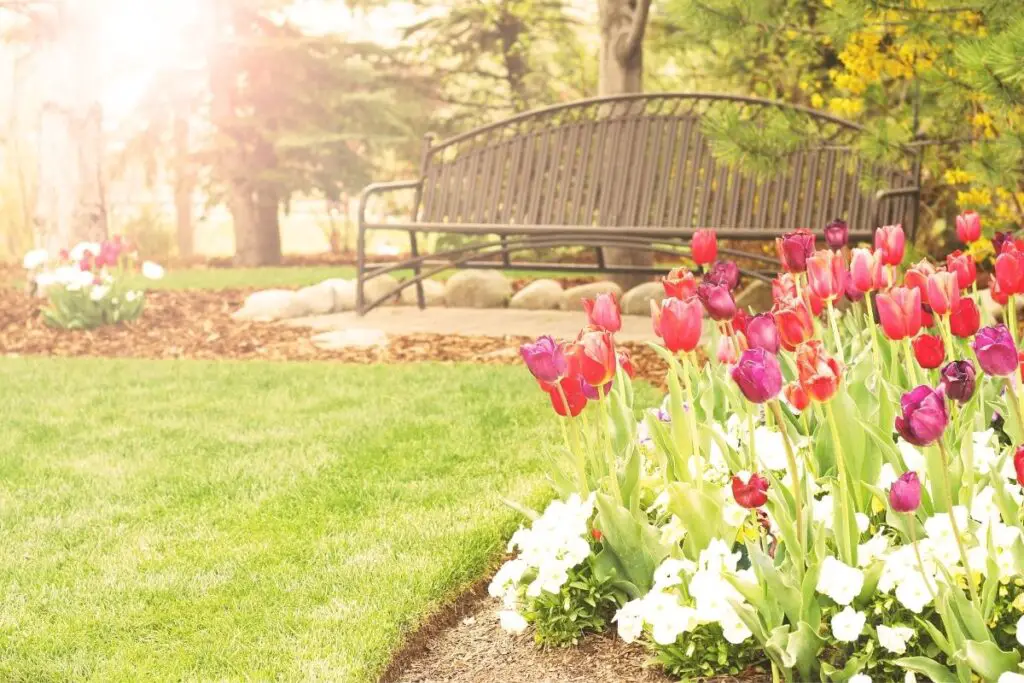
The overall growth of tulip depends on the light it receives. These plants need light for energy to grow, produce seeds, and bloom.
Tulips are sun-loving plants, and they need a minimum of six hours of sunlight daily. The ideal location for tulips must provide them bright, direct sunlight for growth. They might need shade if there’s too much heat.
If tulips don’t get proper sunlight, they can suffer from problems such as:
- Leggy and weak growth
- Fewer flowers
- Dull leaves
Also, sometimes if the growing spot allows too much sun, the tulips can suffer from specific problems such as:
- Tulip leaves will turn yellow and dry.
- The petals of tulips will curl up and have bleached pigments.
Which is the best place to grow tulips in terms of sunlight?
Select a bright and sunny spot in your garden to plant tulips. They will grow best in garden beds or under trees. Ensure that the flower bed is well-drained and fertile.
If you are from zones 8 and 9, choose a shady location or one with the morning sun to plant tulips.
Providing them with some partial shade is beneficial as they will get protection from the sun’s harsh rays, and their flowers will also last longer.
Avoid planting them in an entirely shaded area. Then they will stretch more towards the light and won’t thrive properly. If you are from cool regions, direct sunlight will not be a problem.
It is also essential to determine which spot in your garden or backyard will receive morning sun or harsh afternoon sun and choose the planting location accordingly.
Also read: How Much Sunlight Do Tulips Need? (Tulip Light Needs)
Soil
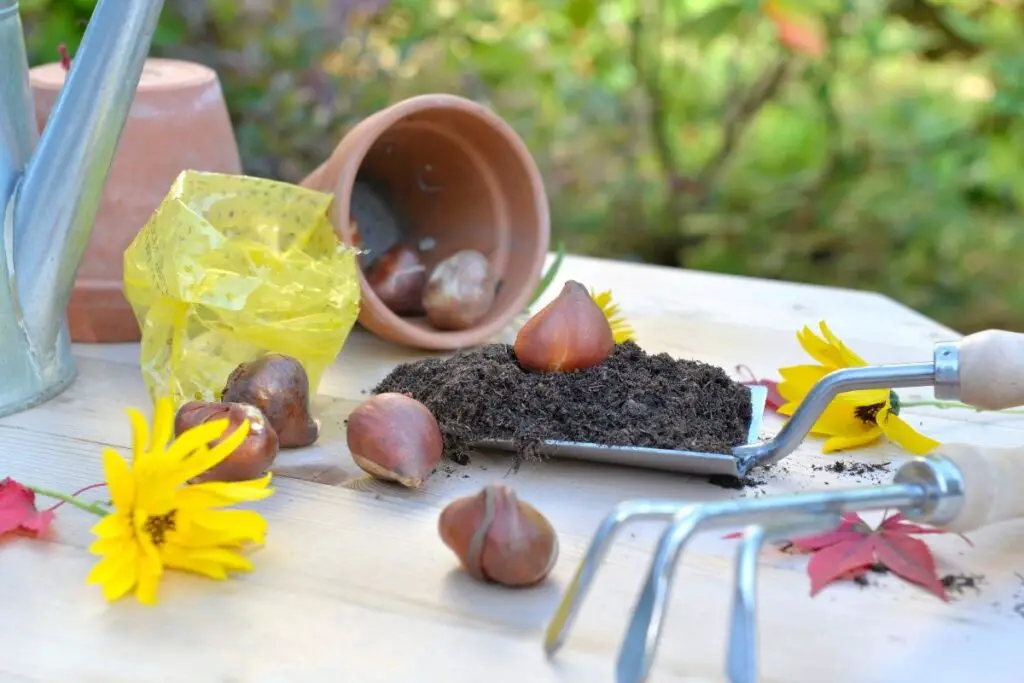
Using a good soil mix at the planting spot will help develop a healthy root system for tulips and provide them with enough nutrients to bloom well.
Tulips thrive in neutral or slightly acidic soil with a pH level of 6.0 to 7.0 on a pH scale. They prefer loose, nutrition-rich sandy or loamy soil to grow. It should be well aerated, light, and absorbent.
Tulips never like to stay in wet conditions and prefer fast-draining soil to avoid overwatering. The soil temperature must be below 60°F.
If you use the wrong soil mix at the planting spot, your tulips can suffer from some problems such as:
- Poor and stunted growth
- Droopy leaves
- Falling leaves
- Dry and cracked soil
Also read: What Kind Of Soil Is Good For Tulips? (Best Soil Mix)
Temperature and humidity
Tulips are cold climate plants, and they love to prosper in cool weather conditions. They do not like direct sunlight, and they will not do well if not planted deep in the soil.
They are hardy plants, but extreme temperature fluctuations can affect them.
Tulips like humidity. Too much heat and humidity can harm them. Proper watering, adequate spacing, and well-drained soil are ways to reduce humidity for tulips.
Also read: What Temperature Do Tulips Need? (+Growing Them At Different Temperature)
What is the temperature for growing tulips in the garden?
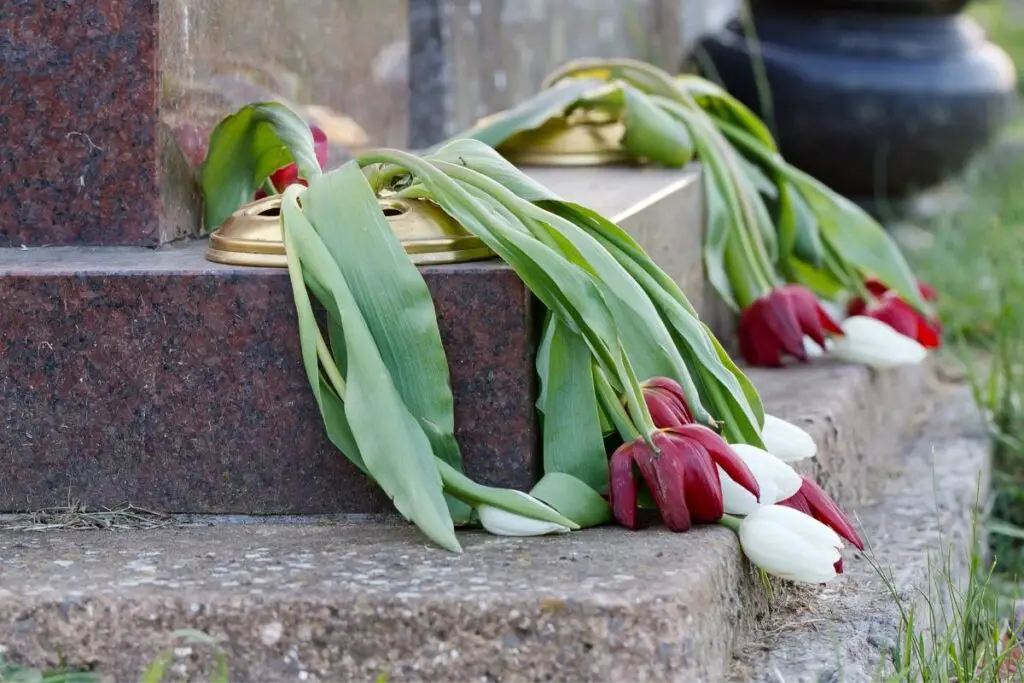
Tulips require a temperature below 55°F to grow. They have a temperature tolerance level of 29°F, but their buds will die if the temperature falls below this level.
They will show signs of growth at 60°F. Before that, you need to provide them with ideal conditions by refrigerating them for at least 15 weeks. If you do not chill them, they will not grow shoots or bloom.
In cooler climates, plant them in a spot where the soil temperature is 60°F or colder. Plant them 6 inches deep in the soil and space them apart as much as the bulbs are wide.
You need to force bulbs in warmer climates by placing them in a loosely packed bag in the refrigerator before planting them.
What are the things you should keep in mind while choosing the ideal spot for planting tulips?
Many factors influence the ideal spot for growing tulips. The selection of a planting spot is not enough, as many other factors will contribute to the healthy growth of tulip plants.
Let’s look at an overview of the ideal conditions for tulips.
Light: Tulips prefer bright direct sunlight for growth. Plant them in a location with at least 6 hours of sunlight daily. They do not like extreme heat so that you can provide them with some partial shade in the form of a tree or wall.
Surrounding environment: Before planting tulips, check the surrounding environment. Do not plant them in a location surrounded by big trees and walls. This may overshadow the tulips, and they will struggle to receive proper sunlight.
They can turn leggy and can become weak, so carefully analyze the surrounding environment before planting them.
Soil: The ideal spot for tulips requires rich loamy or sandy soil that is fertile and contains enough organic matter. Use well-draining soil with a pH range between 6 and 7. You can add compost to improve soil drainage.
Water: To ensure the growth of the tulip’s root system before winter dormancy, you need to water the bulbs before planting. Generally, tulips need little watering as they are susceptible to root rot and overwatering problems.
They need a minimum of 1 inch or 17 mm of water per week, particularly in late or early spring, to help the plant bloom. Make sure that the topsoil feels dry to touch before watering.
Temperature: Tulips will grow best when the temperature is below 55°F. They have a temperature tolerance level of up to 29°F, and they will struggle if the temperature falls below that level.
Ensure that the planting location should provide them with their ideal growing conditions.
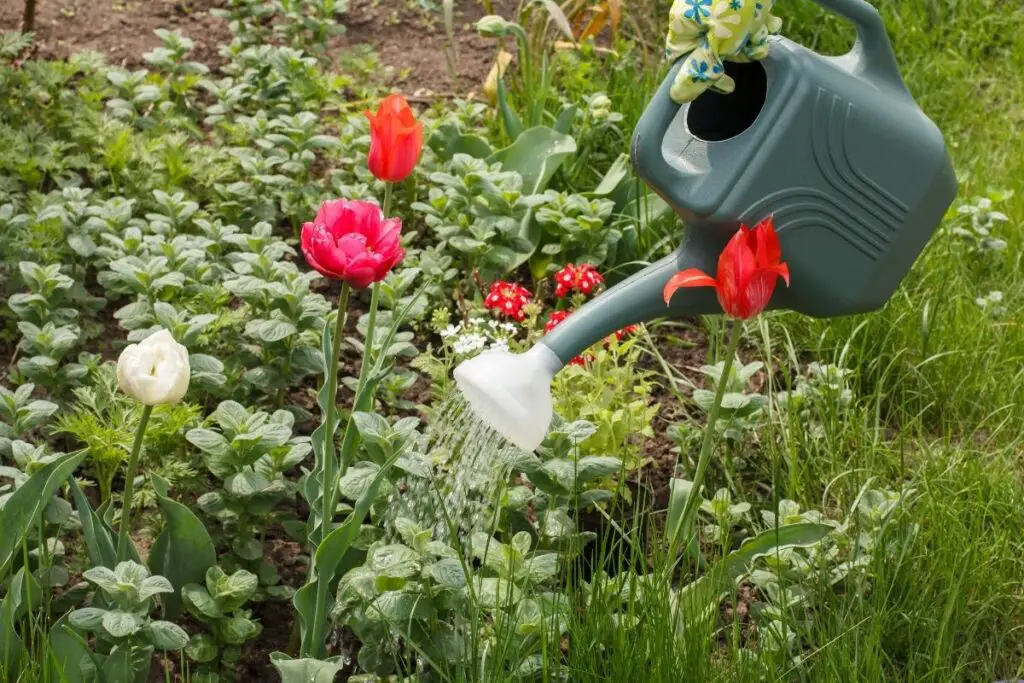
Humidity: Tulips do not prefer much humidity, and they like drier conditions around them. If you are from humid regions, water them less often, do adequate plant spacing and keep them in well-drained soil.
Spacing: While planting tulips, you need to check the space between each tulip plant. Plant the bulbs 4-6 inches apart from each other.
Keeping a good amount of space between them will encourage good air circulation.
Fertilization: Tulips need little fertilization throughout their life. You can fertilize them in the fall every year. The best fertilizer is a slow-release fertilizer with a nutrient ratio of 9:9:6.
Mulching: You can mulch the bulb bed with 2-3 inches of mulch after planting, which will help insulate the soil, maintain soil moisture, and stop soil from splashing on flowers.
Trimming and pruning: Always remove the spent blooms to prevent seed formation but allow the stems and leaves to die back naturally. If you remove stems, bulbs won’t be able to store food for the plant.
Dividing and transplanting: You can divide tulips every 3-5 years when they remain dormant in fall, but make sure you don’t damage them while dividing.
If they seem smaller or stop producing blooms, understand that they need more place to grow. Divide tulips offset from the mother plant and plant them in another location.
Planting: The general criteria for tulip bulbs is to plant them three times as deep as bulbs’ length. You should plant them 6- 8 inches deep.
Deep planting will create fewer chances of sprouting in fall, prevent damage caused by cold air and soil, and protect them from freezing.
Source: Wikipedia, North Dakota Stae University, The Royal Horticultural Society.
